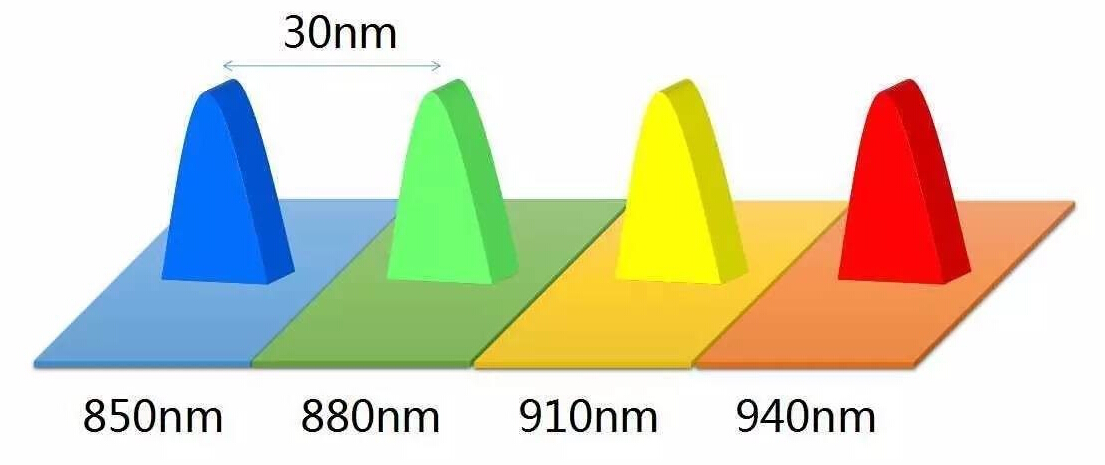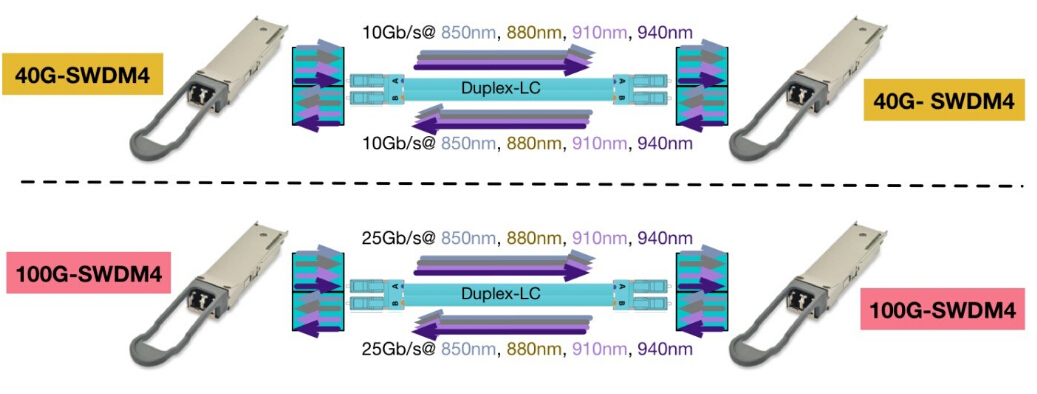Multimode fiber (MMF) holds a major position in local area network (LAN) backbone cabling and data center due to its capability to transmit high data rates at relatively low cost. MMF has evolved now to support multi-gigabit transmission using 850 nm VCSEL (vertical cavity surface emitting laser) sources, and the channel capacity of which is greatly improved with the use of parallel transmission over multiple strands of fiber. Wideband multimode fiber (WBMMF), known as OM5, lately comes into our horizon as an alternative to support the escalating data rate and higher bandwidth. Then what can we expect from using WBMMF? This article may give you some hints.
OM1 and OM2 MMF are developed with the intention to support Fast Ethernet, which fail to support 10 Gbps and 25 Gbps data transmission rates. Hence they are not suggested for new installations. Laser-optimized OM3 and OM4 MMF now play a dominant role in 10G, 40G and 100G Ethernet cabling. However, the demand for bandwidth accelerates so fast, and the VCSEL-based transceiver technology cannot keep pace. Consequently, it’s getting more costly for fiber cabling systems to support next-generation Ethernet migration.
Wideband multimode fiber (WBMMF) is designed to carry multiple short wavelength signals that can be aggregated for high bandwidth applications–—a technology known as wavelength division multiplexing (WDM). Unlike conventional multimode fiber that optimally supports a single wavelength, WBMMF can accommodate multiple wavelengths, enabling these multiple wavelengths to simultaneously travel along a single fiber strand.

In this way, wideband multimode fiber increases each fiber’s capacity by at least a factor of four, allowing at least a fourfold data-rate increase, or a fourfold reduction in the number of fibers. That means, when transmitting four optical signals, instead of using four separate fibers, WBMMF can send down these signals on one fiber over four separate operating windows. For example, 400GbE could be accomplished with 4Tx and 4Rx fibers (today 400GbE over multimode requires 16Tx and 16Rx fibers).
So, what makes wideband multimode fiber standing out from other multimode fibers? Besides that it increases MMF’s utility and extends MMF’s value to customers, WBMMF also has the following advantages:
- Wideband multimode fiber can support wavelength division multiplexing (WDM) across the 840-953nm wavelength range, at 30nm intervals.

- The fiber geometry of WBMMF stays the same as existing OM4 fibers, therefore it is backward compatible with OM4 multimode fiber at 850 nm, making it feasible to retain legacy application support of OM4.
- Wideband multimode fiber reduces fiber count by a faction of four, but increases capacity to over 100 Gb/s per fiber, enabling Ethernet 100G-SR, 400G-SR4, 1600G-SR16 and Fiber Channel 128G-SWDM4.
Wideband multimode fiber provides better performance for applications using WDM technology. As the parallel multimode fiber MPO cabling is considerably more costly than the multimode fiber LC-duplex patch cord, WBMMF made it possible to use a single pair of LC fiber instead of MPO trunks in direct point-to-point connection. Which helps to reduce fiber count by transmitting multiple wavelengths in the same multimode fiber, and to keep the overall cabling costs to the minimum.

Wideband multimode fiber is a reliable medium to expand your data center or enhance network capacity. With the capability of managing multiple wavelengths, it effectively reduces the number of fibers and enhances total channel capacity, proven to be a cost-effective solution for increasing network bandwidth, and to keep pace with the escalating data demands.
Related Article: WBMMF – Next Generation Duplex Multimode Fiber in the Data Center
